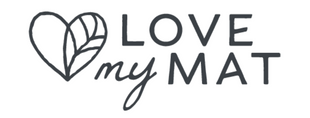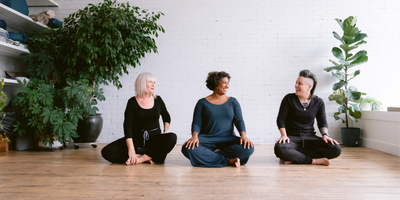Which Yoga Block is Right For You?
We love yoga blocks. They are one of the more versatile and inexpensive yoga props you can own. But there are so many styles of blocks on the market that it can make the choices overwhelming. We're here to help you determine which yoga blocks are the best for you.
There are many factors to consider when purchasing yoga blocks.
- What shape block is best?
- What size do you need?
- What material do you prefer?
- What’s your budget?
- Do you need one or two blocks?
- Are they for home use? Or to practice elsewhere?
First let’s discuss the shape of Yoga Blocks
A traditional yoga block is a rectangle. We like this best because they can be placed in three different ways, resulting in three possible heights: they can be laid flat (lowest height), placed on edge (middle height), or stood on end (tallest height).
As new props get designed to suit our modern lives, we’re seeing different block shapes. You can find egg shaped blocks, octagon shapes, semi circles and rectangular blocks with cut outs. These different shapes all have specific uses that can benefit your yoga practice, but sacrifice versatility.
Next let’s consider the size of your blocks
You can find many different sizes of yoga blocks in the traditional rectangle shape.
9” x 6” x 4” is the traditional size for Yoga Blocks. We believe this is the best size because it’s offers the most stability. Plus, this is what most teachers have learned on and teach with.
9” x 6” x 3” - a popular size block. This size block can be good if you’re carrying your blocks with you to class. They offer less stability for balancing postures, but still have 3 different height options.
9” x 6” x 3.5” - another common size block. It’s between the 4” and 3” sizes and often found in cork or wooden blocks. The slightly smaller size helps to reduce weight while keeping most of the stability.
12” x 8” x 2” - usually found as foam chip blocks or boards. These have been around for a long time and are best to cushion and support your knees, elbows, shoulders and hips. The limitation to these are that you cannot place them in any position other than laying them flat because they will fold or break.
Other Sizes – When you get into egg shaped, octagons and semi circle or rounded yoga blocks, the sizes vary greatly. So best to make sure they are the right height for the specific purpose you need them for.
What’s the best material for your Yoga Blocks?
FOAM – the most commonly found blocks, especially in yoga studios. Foam blocks are the most popular because they are lightweight, inexpensive and available in a huge variety of colours.
Foam yoga blocks have some give, so they are much more comfortable to lay on then cork or wooden blocks. But we recommend only getting 4” wide blocks in foam because if your foam block is too thin it could bend and not provide the support you actually need from a yoga block.
Foam blocks are probably the least eco-friendly option, but until we can find a way to produce something similar that is from a sustainable source, we says foam are the best option in most situations.
Some things to note about Foam Yoga Blocks
• If you sweat a lot in your practice, foam might not be the best option for you. Foam doesn't absorb sweat as well as cork, so they may become slippery.
• All foam blocks are susceptible to wear and tear. They can easily get scratched or dented with regular use.
CORK - cork blocks are becoming more commonly found in yoga studios because they are a much more eco-friendly option than foam blocks. They provide better stability and look pretty good, too.
Cork blocks are much heavier than foam, which makes them super sturdy and durable. The weight of cork blocks can be a benefit to your practice by help your build strength. But if you're carrying blocks to and from class - they may be a bit heavy.
Cork blocks have a somewhat smooth texture but cheaper cork may flake or chip, resulting in an uncomfortable or uneven surface. These blocks are great for hot yoga or those who sweat a lot in their practice because they absorb moisture to create a great non-slip surface.
Cork is sustainable because it is biodegradable and renewable. Cork Oak Trees grow thick bark that can be stripped off every 10 years or so without damaging the trees. These amazing tress can live from 170 to 250 years... that's a lot of cork!
Some things to note about Cork Yoga Blocks
• You can find cork blocks in just about any shape and size.
• Cork is porous so they can be difficult to keep clean or smelling fresh.
• If you purchase low quality cork blocks they may crumble easily.
• Cork blocks are firmer and less forgiving, so they are not as comfortable for laying on.

WOOD - The most common type of wood for wooden yoga blocks is birch, pine or bamboo. Most of these option are the hardest and heaviest of all blocks. We think wooden blocks are great for your home practice, but too heavy to bring with you to and from class. Most blocks are solid wood, but you may be able to find some hollow wooden blocks that aren't very heavy.
Wooden blocks provide sturdy support for balancing exercises. But because they are so rigid and have sharp corners, they are hard on the spine for backbends and many restorative poses.
Wooden blocks are usually the most expensive option, but they are the easiest to keep clean and stack nicely if you have a large amount of them.
You might think that wooden blocks are the most eco-friendly option, and they could be, but it depends on the type of wood used, how it was harvested and any finishes that may have been applied.
Some more things to note about wooden yoga blocks.
• Wood block are non-porous so they are the easiest to keep clean.
• The most durable of all yoga blocks
• Have a lovely, natural aesthetic

How much do you want to spend on blocks?
The cost of yoga blocks varies greatly. In general, foam blocks are the cheapest, then cork blocks followed by wooden blocks. Cost also varies depending on the quality of the materials, where they are made, how they are made and how many you need.
It's important to consider your needs and your budget when deciding which yoga blocks are best for you. Be sure to factor in the longevity of the blocks you choose. The cheapest blocks might seem like the right way to go now, but if you have to replace them in a year or two... does that really make them a good deal?
If you don't have a budget for yoga blocks or any yoga props, there are alternatives you can use. Try a stack of books in place of a yoga block. Use a rolled up tool or pillows to support you in backbends. There are a ton of yoga block and prop alternatives that don't require you spending any money. You can find some more alternatives here.
How Many Yoga Blocks Do You Need?
Do you have a "less is more" mentality? Or are you a "give me all the things" type of person? Choosing the quantity of blocks is really personal preference, but we believe two blocks are better than one.
Of course, you might want 4 blocks or 8 blocks? Maybe you want to build a fort of blocks? Or try the infamous Bed of Nails Savasana? Just make sure you need the amount of blocks you plan to buy.
How many blocks you need also relates to your budget. If you can get away with only having one block and possibly a yoga bolster or another yoga prop, that might be your best bet.
Where Are You Going to Use the Yoga Blocks?
If you're purchasing yoga blocks solely for the purpose of your at home yoga practice, then you don't have to worry about the weight of them. The weight of blocks mostly comes into play if you're planning on bringing them back and forth to your yoga studio. If this is the case, you'll probably want the lightest blocks possible.
Whether you plan to user your yoga blocks at home or in studio, you may want to use blocks as added weights to strengthen your practice and body. If so, you'll want cork or solid wood blocks as they are heavier than foam.
Now that you have all this information, do you know which yoga blocks are best for you?








